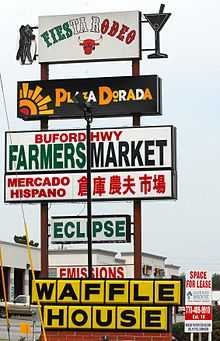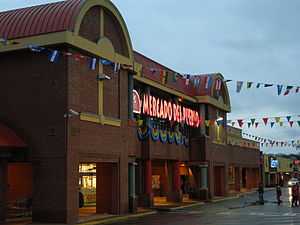Buford Highway

Buford Highway is an international community along and on either side of a stretch of Georgia State Route 13 in DeKalb County, Georgia. It begins just north of Midtown Atlanta, continues northeast through the towns of Brookhaven, Chamblee, and Doraville, and ends 1.3 miles (2.1 km) northeast of the Perimeter (I-285) at the DeKalb/Gwinnett border.
Creative Loafing's Atlanta edition named Buford Highway Atlanta's "best neighborhood for diversity" in their April 2011 "Ultimate Neighborhood Guide" . The population exceeds 50,000.[1]
Community
Buford Highway is a linear community made up of multi-ethnic suburban neighborhoods and shopping centers. Similar to other sun belt cities, immigrants who relocated to Atlanta in the 20th and 21st centuries went straight to the suburbs, where residential and commercial real estate was affordable and where many second-generation immigrant communities were already established. Along Buford Highway, there are few wholly distinct ethnic areas. The more than 1,000 immigrant-owned businesses are owned by and patronized by a wide variety of ethnic groups,[2][3] notably Korean, Mexican, Chinese and Vietnamese, and also Indian/South Asian, Central American, Somalis and Ethiopian. The DeKalb County Chamber of Commerce calls the area the "International Corridor."[4]

The Buford Highway community is home to one of the highest concentration of foreign-born residents in the country, notably Mexican, Central American, Chinese, Korean and Vietnamese. The area attracted many Latino workers during the construction boom that preceded the 1996 Olympic Games. Asian business owners were attracted to the stretch of highway by cheap leases and reliable traffic flow.[5]
History
Buford Highway originated as a non-descript state roadway connecting Atlanta and points northeast, including the then-railroad towns of Chamblee and Doraville, as well as points farther north. The towns of Doraville, Chamblee and Norcross had long been home to a blue collar, largely white, lower middle-class population. The highway was characterized by strip mall development, and apartment complexes sprouted up in the 1960s and 1970s.[2] In 1976 the first ethnic restaurant opened, the Havana Sandwich Shop. In the 1980s, immigrants settled in the area due to affordable housing, available public transportation, and proximity to construction jobs in growing Gwinnett County.[6] The area attracted many Latino workers during the construction boom that preceded the 1996 Olympic Games. Asian business owners were attracted to the stretch of highway by cheap leases and reliable traffic flow.[5]
During the 1996 Olympics, Chamblee embraced the growing international character of Buford Highway, while more conservative Doraville resisted it. As the Southern Foodways Alliance reported:"'Why would we want to attract more immigrants when we got all we want?' asked Doraville mayor Lamar Lang to the press. 'That’s just not our way of life here,' agreed the city council. 'We’re basically Baptists and Methodists and Presbyterians.'"[6]
Streetscape


Buford Highway is, in most places in the corridor, a seven-lane highway with no median and few sidewalks, a situation which is grossly mismatched with the heavy pedestrian traffic along and across the highway.
Most properties along the corridor are in the form of strip malls, retail businesses surrounded by large parking lots, and large apartment complexes. The largest strip malls are the 466,000-square-foot (43,300 m2) Northeast Plaza, 355,000-square-foot (33,000 m2) Plaza Fiesta and the Buford Highway Farmers Market complex.
Pedestrian deaths
On July 22, 2010 PBS's Need to Know program portrayed the corridor as an example of a high-pedestrian area in suburban America that fails to meet increased demand for walkability due to changing demographics.[7] The program noted that in the previous ten years, 30 people had died and an additional 250 were injured while trying to cross Buford Highway, a rate three times higher than any other road in Georgia. Despite this, there are no plans to improve pedestrian safety in the unincorporated area of the corridor.
Public transportation
Buford Highway is served by MARTA bus route 39 (Lindbergh Center to Doraville) as well as privately run "jitneys", or minibuses.[8] Also, the Doraville MARTA metro rail station is a block away from Buford Highway.
Buford Highway in popular culture
The city of Chamblee, in which part of the Buford Highway community is located, is sometimes referred to as "Chambodia" due to its high Asian population and the concentration of Asian restaurants along Buford Highway in Chamblee. A chapter of Tom Wolfe's novel A Man in Full is titled "Chambodia".[9][10]
See also
References
- Walcott, Susan M. (2002). "Overlapping Ethnicities and Negotiated Space: Atlanta’s Buford Highway". Journal of Cultural Geography (University of North Carolina at Greensboro) 20: 51–75. Retrieved 2011-09-09.
- ↑ "Buford Highway Corridor", Cultures for Health, Emory University
- ↑ 2.0 2.1 "What Is Buford Highway?". Buford Highway Project. Retrieved June 28, 2011.
- ↑ "Buford Highway" (PDF). Creative Loafing Ultimate Neighborhood Guide (Atlanta, Georgia: Creative Loafing Atlanta) 39 (48). March 31 – April 6, 2011.
- ↑ "Visitor Information". DeKalb County Chamber of Commerce. Archived from the original on May 25, 2009. Retrieved June 28, 2011.
- ↑ 5.0 5.1 Moreno Gonzales, John (March 10, 2009). "Immigrants along Buford Highway face mixed signals". The Atlanta Journal-Constitution. Associated Press. Retrieved March 10, 2009.
- ↑ 6.0 6.1 "City Guide Atlanta/Buford Highway" (PDF). Southern Foodways Alliance. Retrieved June 28, 2011.
- ↑ Larson, John (Correspondent), Moore, Fae (Producer) (July 22, 2010). Dangerous Crossing. PBS. Retrieved July 29, 2010.
- ↑ "Response to Recent Conversation", '"Atlanta Journal-Constitution, August 26, 2013
- ↑ Neal Becton, "Atlanta's 'Chambodia,' a 'Burb With a Global Flavor", Washington Post, April 18, 1999
- ↑ Cliff Bostock, We heart Chambodia", Creative Loafing, January 8, 2004
| |||||||||||||||||||||||
Coordinates: 33°52′36″N 84°17′36″W / 33.8766°N 84.2932°W
